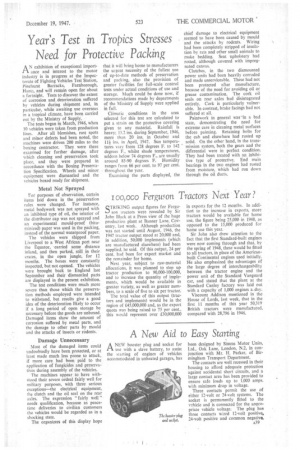Year's Test in Tropics Stresses •
Page 49

If you've noticed an error in this article please click here to report it so we can fix it.
Need for Protective Packing A N exhibition of exceptional import
ance and interest to the motor industry is in progress at the Inspectorate of Fighting Vehicles Test Station, Pinehurst Barracks, Farnborough, Hants, and will remain open for about a fortnight. Tests to discover the extent of corrosion and, deterioration suffered by vehicles during shipment and, in particular, while awaiting use overseas in a tropical climate, have been carried out by the Ministry of Supply.
The tests began in March, 1946, when 10 vehicles were taken from production lines. After all blemishes, rust spots and minor defects had been noted, the machines were driven 200 miles to the boxing contractor. They were there examined for further damage, after which cleaning and preservation took place, and they were prepared in accordance with the Boxing Preservation Specification. Wheels and minor equipment were dismantled and the vehicles boxed ready for shipment.
Metal Not Sprayed
For purposes of observation, certain items laid down in the preservation rules were changed. For instance, metal bodywork was not sprayed with an inhibited type of oil, the interior of the distributor cap was not sprayed and an experimental mould-proof (bituminized) paper was used in the packing, instead of the normal waterproof paper.
The vehicles were shipped from Liverpool to a West African port near the Equator, -carried some distance inland, and then parked, still in their crates, in the open jungle, for 12 months. The boxes were constantly inspected, but not opened. The vehicles were brought back to England last September and their dismantled parts are displayed in the present exhibition.
The test conditions were much more severe than those which the preservation methods employed were intended to withstand, but results give a good idea of the deterioration likely to occur if a long period of open storage be necessary before the goods are unboxed. Damaged items show the amount of corrosion suffered by metal parts, and the damage to other parts by mould and the attacks of insects or rodents.
Damage Unnecessary
Most of the damaged items could undoubtedly have been protected, or at least made much less prone to attack, if more care had been paid to the application of fungicides and preservatives during assembly of the vehicles.
The machines appear to have withstood their severe ordeal fairly well for military purposes, with three serious exceptions—the electrical equipment, the clutch and the oil seal on the rear axles. The expression "fairly well " • needs qualification, because as peacetime deliveries to civilian customers the vehicles would be regarded as in a shocking state.
The organizers of this display hope that it will bring home to manufacturers the urgent necessity of the fullest use of up-to-date methods of preservation and packing, also the provision of greater facilities for full-scale control tests under actual conditions of use and storage. Much could be done now, if recommendations made by departments of the Ministry of Supply were applied in full.
Climatic _ conditions in the area selected for this test are calculated to put a strain on the protective covering given to any material. Rainfall is heavy; 13.2 ins. during September, 1946, more than 20 ins. in October and 1l ins. in April, 1947. Sun temperatures vary from 128 degrees F. to 142 degrees F., whilst shade temperatures, seldom below 74 degrees F., are usually around 85-90 degrees F. Humidity ranges from 66 per cent. to 97 per cent. throughout the year.
Examining the parts displayed, the chief damage to electrical equipment seemed to have been caused by mould and the attacks by rodents. Wiring had been completely stripped of insulation by rats and other small animals to make bedding. Seat upholstery had rotted, although covered with impregnated canvas.
Clutches, in the two dismounted power units had been heavily corroded and made unserviceable. These had not been protected after manufacture, because of the need for avoiding oil or grease contamination. The cork oil seals on rear axles had disintegrated entirely. Cork is particularly vulnerable. In contrast, brake facings had not suffered at all.
Paintwork in general was 'in a bad state, demonstrating the need for extreme care in cleaning metal surfaces before painting. Retaining bolts for the cab and elsewhere had rusted up solid. On the other band, in the transmission system, both the gears and the differential were in perfect condition: They had been treated with an inhibitive type of protective. End main bearings in the two engines had rusted from moisture, which had run down through the oil ducts.












































































